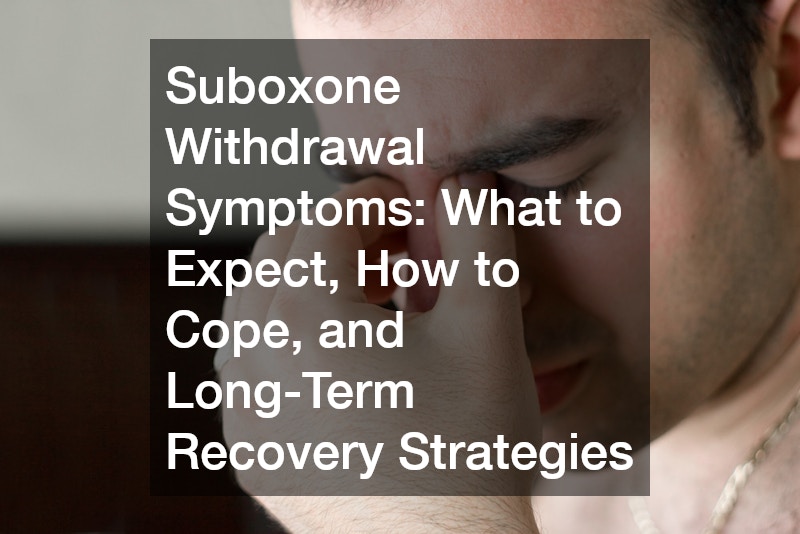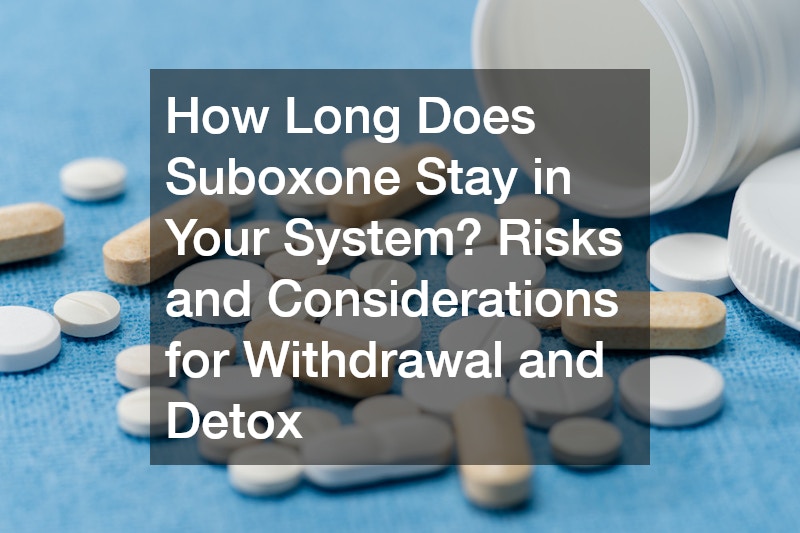If you or someone you know is tapering off Suboxone, it’s natural to feel nervous about what lies ahead. Suboxone, a combination of buprenorphine and naloxone, is commonly used to treat opioid addiction. While it helps manage cravings and withdrawal initially, stopping it can trigger Suboxone withdrawal symptoms that range from mild to severe. Knowing what to expect—and how to manage it—can make the process less intimidating and more manageable.
In this article, we’ll break down the symptoms, the timeline, and practical coping strategies to support recovery.
What Are Suboxone Withdrawal Symptoms?
Suboxone withdrawal symptoms occur when your body adjusts to the absence of buprenorphine, an opioid partial agonist. Because Suboxone changes brain chemistry to help reduce cravings and prevent relapse, stopping it suddenly can leave your body in a state of shock. Withdrawal symptoms are your body’s way of signaling that it’s trying to rebalance itself after prolonged exposure to opioids.
Symptoms vary depending on factors like how long you’ve been taking Suboxone, your dosage, your overall health, and whether you taper gradually or stop abruptly. Some people experience only mild discomfort, while others may go through more intense physical and psychological effects. Knowing the signs ahead of time can help you prepare both mentally and physically.
Physical Symptoms to Expect

When it comes to physical withdrawal symptoms, many people notice a range of discomforts. Muscle aches, joint pain, and a general sense of weakness are common in the early days. Your body may experience sweating, chills, or goosebumps as it reacts to the absence of buprenorphine. Gastrointestinal symptoms like nausea, vomiting, and diarrhea are also frequent and can contribute to dehydration if not managed.
Some people report increased heart rate, blood pressure changes, and insomnia. These symptoms may fluctuate throughout the day, often peaking in intensity in the first week after reducing or stopping Suboxone. Although physical symptoms can be challenging, they are usually temporary and improve as the body adjusts.
Psychological Symptoms: The Hidden Challenge
Withdrawal isn’t only about physical discomfort; mental and emotional symptoms can sometimes be more difficult to handle. Anxiety, restlessness, and irritability are common, and mood swings can make daily routines feel overwhelming. Many individuals experience depression or a low mood, especially if withdrawal coincides with other life stressors.
Difficulty concentrating and persistent cravings for opioids or Suboxone itself are also frequent during withdrawal. These cravings are triggered by both psychological dependence and changes in brain chemistry. Recognizing that these symptoms are a normal part of the process can help reduce feelings of panic or frustration.
Timeline of Suboxone Withdrawal Symptoms
One of the most common questions is: “How long will withdrawal last?” While the timeline varies from person to person, a general pattern emerges for most people.
- Days 1–3: The first signs of withdrawal typically appear. You may notice mild anxiety, restlessness, sweating, muscle aches, and trouble sleeping. Some people feel an increased heart rate or mild nausea.
- Days 4–7: Symptoms tend to intensify. Physical discomfort, diarrhea, and insomnia may peak, and psychological symptoms like irritability and cravings often become stronger.
- Weeks 2–4: Physical symptoms generally begin to ease, but psychological effects, such as anxiety and cravings, can persist. Fatigue and mood swings may continue during this period.
- Weeks 4+: Some individuals experience post-acute withdrawal symptoms (PAWS). These may include occasional mood swings, fatigue, anxiety, or lingering cravings. While these symptoms are usually less intense, they can still challenge recovery if not managed properly.
A gradual taper under medical supervision can help shorten this timeline and reduce the severity of symptoms.
Why Does Suboxone Withdrawal Happen?
Withdrawal occurs because your body has adapted to the presence of opioids. Suboxone binds to opioid receptors in the brain, reducing cravings and mitigating withdrawal from other opioids. When you stop taking it, your brain’s neurotransmitters, especially those regulating mood, pain, and reward, need time to rebalance.
This chemical adjustment triggers the physical and psychological symptoms associated with withdrawal. Stopping abruptly often leads to more intense symptoms, whereas a carefully planned taper allows your body to adjust gradually, making the process more tolerable.
Coping With Suboxone Withdrawal Symptoms
While withdrawal can be uncomfortable, there are strategies that can make the process more manageable. Combining medical guidance with self-care and lifestyle adjustments can significantly reduce discomfort and support recovery.
Follow a Tapering Plan
A gradual taper is the safest approach to minimizing withdrawal symptoms. Working with a healthcare provider, you can develop a personalized plan that reduces your Suboxone dose over time. A tapering schedule allows your body to slowly adapt to lower doses, reducing physical pain, nausea, and psychological stress. This method also decreases the risk of relapse, as sudden cessation can trigger strong cravings.
Maintain Hydration and Nutrition
Suboxone withdrawal often leads to dehydration due to sweating, diarrhea, or vomiting. Staying hydrated is essential. Water, electrolyte solutions, or herbal teas can help replenish fluids and prevent further complications.
Nutrition is equally important. Eating nutrient-rich foods supports your body’s recovery. Focus on lean protein, fruits, vegetables, and whole grains. Avoid caffeine and alcohol, which can increase anxiety, irritability, and dehydration. Small, frequent meals may also help manage nausea and provide consistent energy throughout the day.
Manage Symptoms With Over-the-Counter Remedies
Some mild withdrawal symptoms can be alleviated with over-the-counter medications. Pain relievers like acetaminophen or ibuprofen may help with muscle aches and headaches. Anti-diarrheal medications can reduce gastrointestinal discomfort, while sleep aids or melatonin may support rest during insomnia. Always consult a healthcare professional before combining medications, particularly during withdrawal, to avoid interactions or complications.
Use Mind-Body Techniques
Addressing the psychological component of withdrawal is crucial. Mind-body techniques like deep breathing, meditation, or progressive muscle relaxation can reduce anxiety and improve emotional stability. Light exercise, such as walking, yoga, or stretching, can boost mood, alleviate muscle tension, and improve sleep quality. Journaling or mindfulness exercises can help track symptoms and provide an outlet for stress and cravings.
Seek Support From Others
Withdrawal can feel isolating, but support from others makes a significant difference. This can include counseling, therapy, support groups, or even informal encouragement from friends and family. Talking openly about your experiences normalizes your feelings and can reduce anxiety. Online communities for individuals tapering off Suboxone also offer a safe space to share experiences and coping strategies.
Consider Medical Assistance
In certain cases, short-term medications may be recommended by a doctor to ease withdrawal symptoms. For example, clonidine can help with anxiety, sweating, and elevated blood pressure, while anti-nausea or sleep aids can make the process more tolerable. Medication-assisted support should always be overseen by a healthcare professional to ensure safety and effectiveness.
Frequently Asked Questions About Suboxone Withdrawal Symptoms
What is the hardest part of withdrawal?
Many people find psychological symptoms—like cravings, anxiety, and mood swings—more difficult than physical symptoms. Being prepared for these mental challenges helps you develop coping strategies ahead of time.
Can withdrawal occur after a long taper?
Yes. Even with a gradual taper, some mild withdrawal symptoms may persist. Fatigue, irritability, or occasional cravings can appear weeks after the final dose. While usually temporary, being aware of this possibility helps manage expectations.
Is withdrawal dangerous?
Suboxone withdrawal is generally not life-threatening, but complications can arise, especially for those with other health conditions. Medical supervision reduces risks and ensures safer symptom management.
When should I seek medical help?
Seek professional support if you experience severe dehydration, intense anxiety, panic attacks, high blood pressure, or thoughts of self-harm. Immediate assistance can prevent complications and support your recovery.
Long-Term Strategies to Prevent Relapse

Successfully completing withdrawal is only the first step in recovery. Maintaining sobriety and preventing relapse requires ongoing effort and intentional strategies. Here are key approaches:
Engage in Therapy
Cognitive-behavioral therapy (CBT) and other forms of counseling can help you identify triggers, manage cravings, and address negative thought patterns. Therapy provides tools to cope with challenges before they lead to relapse.
Adopt Healthy Lifestyle Changes
Regular exercise, hobbies, and social engagement not only improve physical health but also enhance mood and resilience. Staying active and finding fulfilling activities can reduce stress and prevent boredom, which often triggers cravings.
Build a Strong Support System
Support networks—such as recovery groups, counseling, or accountability partners—offer guidance, encouragement, and a sense of community. Having people to turn to during difficult moments significantly increases the chances of long-term success.
Avoid High-Risk Environments and Triggers
Steer clear of places, situations, or people associated with past opioid use. Limiting exposure to potential triggers helps reduce the risk of relapse and supports a stable recovery journey.
By integrating these strategies into daily life, individuals can strengthen their recovery and maintain lasting sobriety.
In Summary
Experiencing Suboxone withdrawal symptoms can be challenging, but with preparation, support, and the right strategies, it is possible to navigate the process safely and successfully. Understanding what to expect, from physical aches and gastrointestinal issues to anxiety and cravings, empowers you to manage symptoms proactively. Gradual tapering under medical supervision, combined with proper hydration, nutrition, mind-body techniques, and emotional support, can significantly ease discomfort.
Recovery is a journey that extends beyond withdrawal, and adopting long-term strategies like therapy, lifestyle changes, and strong support networks ensures continued progress. While withdrawal may feel overwhelming at times, approaching it with knowledge, patience, and support can transform it into a manageable step toward lasting sobriety and improved well-being.


